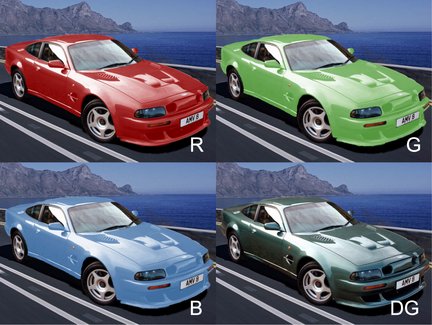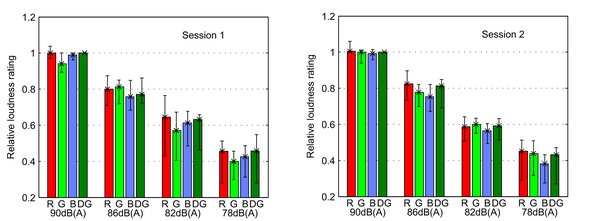


Can colors influence loudness?
Daniel Menzel - menzel@tum.de
Elias Faccinelli
Hugo Fastl
AG Technische Akustik
Lehrstuhl für Mensch Maschine Kommunikation
Technische Universität München
Arcisstraße 21, 80333 München
Popular version of paper 2aPPa15
Presented Tuesday afternoon, July 1, 2008
Acoustics’08, Paris, France
In the fields of sound design and sound-quality engineering, the sound of products like cars or printers is modified until it reaches a desired goal: a sports car should have a powerful sound, whereas a printer should be unobtrusive and make as little sound as possible. Therefore, loudness plays an important role in the sound design process. In a psychoacoustic context, loudness is often measured in listening tests, where human subjects are asked to rate the perceived loudness of different product-sounds, e.g. by typing in numbers on a computer keyboard corresponding to loudness perception -- the louder the sound, the higher the number. Changes in the construction of a product can thus be directly related to changes in subjective loudness ratings.
Usually, these listening tests are conducted in sound-proofed booths, and the product-sounds are presented via headphones. This helps to eliminate all other possible influences so that the subjects can concentrate on the task of loudness judgments. But in real life, a product’s sound rarely occurs in isolation: normally you see and hear a product simultaneously, for example you can see a car passing by and also hear its motor sound. The question is if this additional visual input significantly affects the perception of an accompanying sound.
To investigate if different images can influence how loud a sound is perceived, an experiment was performed using pictures of sports cars in various colors. The task of the subjects was to listen to sounds of an accelerating sports car while looking at the picture of a red (R), light-green (G), blue (B), or dark-green (DG) sports car (see Fig. 1). After each sound, they had to rate how loud they thought the car was by giving a corresponding number.
.

Fig. 1: Images of differently colored sports cars used as visual input in the experiment.
The sounds were presented with four different levels (90, 86, 82, and 78dB(A)) to make it harder for the subjects to remember which sounds they already heard. Sixteen subjects participated in this experiment, which was split in two sessions.
Fig. 2 shows the results of this experiment. The numbers which were given by the subjects were first normalized so that the perceived loudness of the dark-green car combined with the loudest sound (90dB(A)) corresponds to 1 (100%). In most cases, red cars seemed louder than blue or light-green cars for the same sound. For the loudest sound in session 1 for example, the sound associated with the red car was perceived as being approximately 5% louder than the same sound combined with a light-green car. Dark green also seems to elicit somewhat higher loudness ratings than light green or blue.

Fig. 2 Results of the loudness rating experiment. For each tested sound-level , the answers of the subjects are plotted, normalized to the dark-green car at 90dB(A).
In this study, different colors showed the ability to influence how subjects rated the loudness of sports cars. Red cars were perceived as being louder than light-green or blue cars. This confirms the results of previous experiments, in which red passenger trains also seemed louder than green passenger trains.
More information on audio-visual interactions can be found on our homepage (partly in German): http://www.mmk.ei.tum.de/~tal/medien/